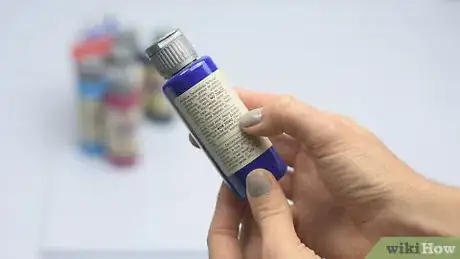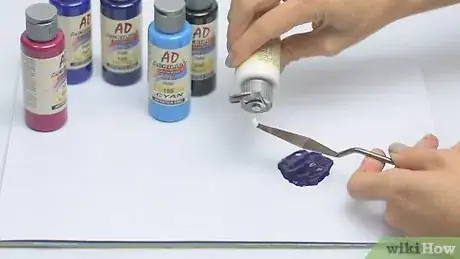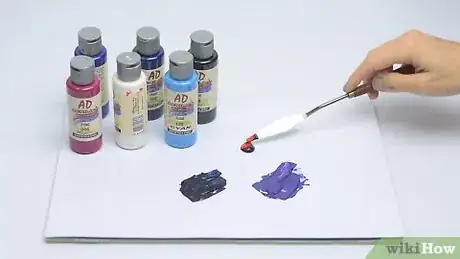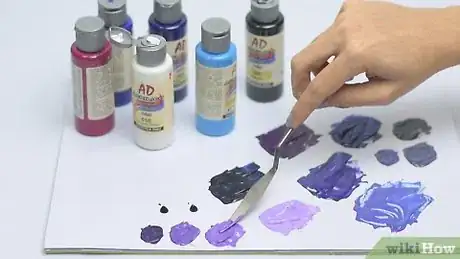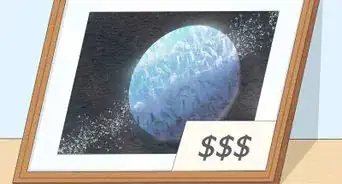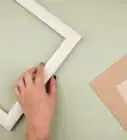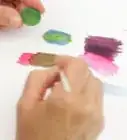This article was co-authored by Renée Plevy. Renée Plevy is an Internationally Acclaimed Portrait Artist from New York/Palm Beach who has painted The Grand Dames of Palm Beach and various celebrities and community leaders. With over 50 years of experience, Renée specializes in painting realistically in oil and capturing the soul of the person. She has studied under internationally renowned portrait artists John Howard Sanden, David Leffel, Robert Beverly Hale, Clyde Smith, and Leonid Gervits. Renée is featured in over 68 shows and galleries including a one-woman museum show at the Paterson Museum. She has garnered numerous awards including “Artist of the Year” from The Bloomfield Art League and First Prize from the Boca Raton Museum Artist’s Guild. Renée has even painted a portrait of celebrity, Vanilla Ice. She also teaches at the Boca Raton Museum Art School - formerly at SVA in Manhattan.
wikiHow marks an article as reader-approved once it receives enough positive feedback. In this case, 100% of readers who voted found the article helpful, earning it our reader-approved status.
This article has been viewed 1,754,806 times.
Many people think that making purple paint is as simple as mixing red and blue paint, but if you’ve tried to do this, you know that this isn’t always the case. To make the perfect purple, which is a bright, clean, tint-free color, select red and blue paints that are free of yellow or green pigments—these pigments will turn what should be a beautiful purple into a murky brown or gray. Once you know how to mix a perfect purple, adjust the shade by adding more red, blue, white, or even black to your mix.
Things You Should Know
- Mix equal parts permanent rose and ultramarine blue paint to make pure purple.
- Add more ultramarine blue in small increments to create a darker, richer, deeper purple. Add more permanent rose for a warmer shade of purple.
- Mix in small amounts of black or white paint to darken or soften the purple shade.
Steps
Mixing the Perfect Purple
-
1Read the labels of your paints to find ones that contain few pigments. When trying to make purple paint, yellow or green pigments can be disastrous. For example, if a red paint lists a yellow pigment, it will have a yellow color bias, meaning that the color yellow will affect any paint you try to mix the red paint with.[1]
- Think about it this way: when you mix yellow paint with purple paint, you end up with a brown or gray color. If yellow is present in the red or blue you choose to use, the same thing is going to happen in the end.
-
2Test your red and blue paint for color bias by mixing them with white. When true red paint (without a yellow color bias) is mixed with white paint, it should change to pink (rather than peach). True blue paint that doesn’t have a green bias mixed with white paint should change to sky blue.[2]
- When you’re testing your paint colors, you don’t need to use much paint at all. Just a small dollop of each will be enough for you to mix them together and view the results.
Tip: Wipe off your paintbrush or palette knife with a paper towel in between mixing colors so you don’t contaminate your blue with red or vice versa.
Advertisement -
3Choose paints that don’t contain a yellow or green color bias. Red paint with a blue bias or blue paint with a red bias will work perfectly fine. Any time yellow in any way is present in your red or blue paint, the purple color won’t come out right—instead, it’ll look brown. Similarly, a green bias will make your purple paint look gray. Read the labels and test the paints by mixing them with white to make sure you’re picking the right shades.[3]
- If you do use a blue paint with a green color bias and mix it with a true red, you’ll get a dark shade of purple that is closer to gray than it is to purple.
-
4Use permanent rose and ultramarine blue to make pure purple paint. Mix equal amounts of these colors together. These two shades of paint mix together really well to make what art experts call the “perfect purple.”[4] It’ll be the most similar to what you might buy from a store in a pre-mixed tube. Permanent rose doesn’t have any yellow in it, and ultramarine blue doesn’t contain any green.[5]
- Quinacridone magenta and primary magenta also work well in place of permanent rose.
Different Shades of Purple
-
1Make the right shade by mixing small amounts of paint at a time. As a rule of thumb, add small amounts of alternate shades to your purple paint when you’re creating something new. It’s easy to add more if you need it, but it’s nearly impossible to get a shade back to its original color if you add too much of something.[6]
- For example, if you’re adding white to a shade of purple to make it lighter, don’t add the same quantity of white as there is purple. Start with just a small dab of paint—enough to cover the tip of a palette knife—and add more if it’s needed.
-
2Add more blue than red for a deeper purple. If your goal is a darker, richer, deeper purple, simply use more ultramarine blue than you do permanent rose. Add the blue in small increments—it’s easy to add more blue but it’s impossible to take it away once it is mixed in.[7]
- You could also add a little bit of black paint to the mix to deepen the color even more. Just be cautious—too much black could overtake the purple.
-
3Create a warmer shade of purple by adding more red to the mix. After mixing up a batch of perfect purple, gradually add more red to create a lighter, warmer shade of purple. Be careful to mix together the paint completely so there aren’t any patches of pure red or pure blue leftover.[8]
- Try adding a small amount of white paint to this mix if you want to soften your purple even more.
-
4Mix permanent rose and cerulean blue to make a dark purple. Always use a true red that has no yellow bias. Cerulean blue does have a slight green bias, but adding it to the permanent rose will produce a darker shade of purple that has gray undertones.[9]
- The more cerulean blue you add, the darker the shade of purple will be.
-
5Combine cyan and magenta to make an electric purple. If you’re looking for a bright, shocking purple, use cyan, which does have some green hues in it, and magenta, which is a purple-red paint.[10]
- The more magenta you add, the pinker your purple will become.
-
6Put white paint in your purple paint to make lighter shades of purple. This is a really simple way to make some lovely light shades of purple, like amethyst, lavender, and pastel purple.[11] Add a small dollop of white paint to the end of your paintbrush or palette knife and thoroughly mix it in with the purple paint.[12]
- If you have multiple hues of purple paint, it could be fun to see how each one changes and what colors you can achieve by adding white to the mix.
-
7Use small amounts of black paint to make darker shades of purple. You can make Spanish purple, tyrian purple, old heliotrope, and other shades by adding really small amounts of black to various hues of purple paint. Black can overwhelm a color really quickly, so add it sparingly and continue adding more until you achieve the color you’re looking for.[13]
Try This Out: Make a color gradient that shows the different shades you get when you mix different amounts and colors of paint together—you can use this chart when you need to mix a specific hue in the future.
-
8Alter a pre-mixed purple with white to create various shades of purple. If you don’t have the true blue and true red that are needed to make a basic shade of purple at home, you can use pre-mixed purple and white paint to make an array of purple shades. Put some purple paint on your palette, and gradually add in small amounts of white paint to get lighter shades.[14]
- Don’t be afraid to play around with your other paints, too! Although yellow will turn purple paint brown, you may have some other colors you’d like to try mixing in. It won’t hurt anything, and you’ll learn something in the process.
Expert Q&A
-
QuestionHow do I make a lavender color?
 Renée PlevyRenée Plevy is an Internationally Acclaimed Portrait Artist from New York/Palm Beach who has painted The Grand Dames of Palm Beach and various celebrities and community leaders. With over 50 years of experience, Renée specializes in painting realistically in oil and capturing the soul of the person. She has studied under internationally renowned portrait artists John Howard Sanden, David Leffel, Robert Beverly Hale, Clyde Smith, and Leonid Gervits. Renée is featured in over 68 shows and galleries including a one-woman museum show at the Paterson Museum. She has garnered numerous awards including “Artist of the Year” from The Bloomfield Art League and First Prize from the Boca Raton Museum Artist’s Guild. Renée has even painted a portrait of celebrity, Vanilla Ice. She also teaches at the Boca Raton Museum Art School - formerly at SVA in Manhattan.
Renée PlevyRenée Plevy is an Internationally Acclaimed Portrait Artist from New York/Palm Beach who has painted The Grand Dames of Palm Beach and various celebrities and community leaders. With over 50 years of experience, Renée specializes in painting realistically in oil and capturing the soul of the person. She has studied under internationally renowned portrait artists John Howard Sanden, David Leffel, Robert Beverly Hale, Clyde Smith, and Leonid Gervits. Renée is featured in over 68 shows and galleries including a one-woman museum show at the Paterson Museum. She has garnered numerous awards including “Artist of the Year” from The Bloomfield Art League and First Prize from the Boca Raton Museum Artist’s Guild. Renée has even painted a portrait of celebrity, Vanilla Ice. She also teaches at the Boca Raton Museum Art School - formerly at SVA in Manhattan.
Portrait Artist & Educator Start by mixing equal amounts of blue and red paint. Then, slowly mix in a little dabs of white paint to lighten the purple to a lavender color.
Start by mixing equal amounts of blue and red paint. Then, slowly mix in a little dabs of white paint to lighten the purple to a lavender color. -
QuestionHow do you make purple with watercolors?
 wikiHow Staff EditorThis answer was written by one of our trained team of researchers who validated it for accuracy and comprehensiveness.
wikiHow Staff EditorThis answer was written by one of our trained team of researchers who validated it for accuracy and comprehensiveness.
Staff Answer wikiHow Staff EditorStaff AnswerMix blue and red shades that are already slightly biased towards each other. For example, ultramarine blue, brilliant blue, and cobalt blue all have a slight red bias. Alizarin crimson, carmine, magenta red, and crimson lake are all cool reds with a slight blue cast. Mix those types of colors together to avoid getting a muddy or brownish shade of purple.
wikiHow Staff EditorStaff AnswerMix blue and red shades that are already slightly biased towards each other. For example, ultramarine blue, brilliant blue, and cobalt blue all have a slight red bias. Alizarin crimson, carmine, magenta red, and crimson lake are all cool reds with a slight blue cast. Mix those types of colors together to avoid getting a muddy or brownish shade of purple. -
QuestionWhat do I add to light green to make it purple?
 Community AnswerAdding red and maybe blue might give you a purplish brown, but you cannot use green to make purple.
Community AnswerAdding red and maybe blue might give you a purplish brown, but you cannot use green to make purple.
Things You’ll Need
Making a Perfect Purple Paint
- Paintbrushes
- Paint palette
- Cup or jar of water
- Paper towels
- Paint
Mixing Different Shades of Purple
- Paintbrushes
- Paint palette
- Cup or jar of water
- Paper towels
- Paint
References
- ↑ https://arthearty.com/how-to-make-purple-paint
- ↑ https://youtu.be/IUc31f0A7CQ?t=22
- ↑ https://www.celebratingcolor.com/red-blue-dont-make-purple-2/
- ↑ Renée Plevy. Portrait Artist & Educator. Expert Interview. 7 May 2021.
- ↑ https://www.celebratingcolor.com/red-blue-dont-make-purple-2/
- ↑ https://arthearty.com/how-to-make-purple-paint
- ↑ https://arthearty.com/how-to-make-purple-paint
- ↑ https://arthearty.com/how-to-make-purple-paint
- ↑ https://www.celebratingcolor.com/red-blue-dont-make-purple-2/
- ↑ https://arthearty.com/how-to-make-purple-paint
- ↑ Renée Plevy. Portrait Artist & Educator. Expert Interview. 7 May 2021.
- ↑ https://arthearty.com/how-to-make-purple-paint
- ↑ https://arthearty.com/how-to-make-purple-paint
- ↑ https://youtu.be/IUc31f0A7CQ?t=348
About This Article
To make purple paint using red and blue paint, start by testing your red and blue paints to make sure they’re “true” red and blue, with no undertones of yellow or green. To do this, simply mix each individual color with a little bit of white paint to see what color they produce. The red paint should become a light pink, not peach, and the blue should become sky blue, rather than teal. If your paints are true blue and red, pour equal amounts of each color onto a palette and use a paintbrush to mix them together thoroughly to create a true purple shade. To learn how to make different tints and shades of purple paint, keep reading the article!
